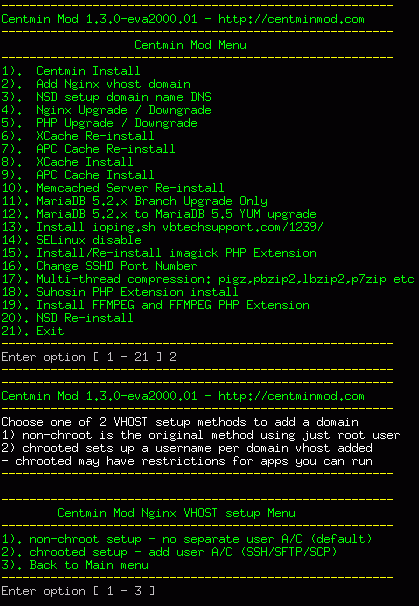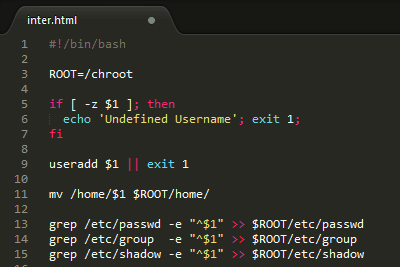How To Chroot
Winbook laptops & desktops driver download. Was configuring SSH CHROOT on RedHat Enterprise Linux 5.3 but I have a problem with it.
My problem is that when a I login with a chrooted user through putty, after entering password putty session is closed and when I view message in log file in /var/log it shows that session is disconnected by localhost.
Now when the user logs in, the ssh key is looked up in /home//.ssh as per /etc/passwd, a chroot is done into /home//sftp, and then a cd is done into /home/ inside the chroot. In other words, the user's remote working directory will appear as /home/. Restrict chroot users to sftp connections using ssh keys without affecting normal user's access.
Solution:
The newer versions of ssh(4.8p1 or higher) has a built in chroot environment that I usually use for sftp only connections. I have some notes on setting up an sftp only chrooted ssh environment that I will post below. I'm sure it has some mistakes and typos, but it should get you going in the correct direction.
##############################################################
# Installing a new SSH server to handle chrooted sftp requests
##############################################################
We are going to keep our current ssh rpm install open to our internal addresses and install a openssh version later than 4.8p1 under /usr/local/openssh just for the chrooting the incoming secure ftp connections. We will do this by restricting the local openssh to listen on the internal ip address and installing a new ssh server to listen on the ip address of the external interface. In this example, we are going to bind the redhat yum installed ssh server to the local ip address 192.168.0.6 address. We are going to set up a second later version of chrooted ssh to the external 10.0.0.100 address.
1> Restrict the current rpm based openssh install to the internal ip address.
# sudo vi /etc/ssh/sshd_config
# Change the ListenAddress 0.0.0.0(all) to the internal ip address(eth2)
ListenAddress 192.168.0.6
Drivers xaplos. # sudo /sbin/service sshd restart
2> Install an ssh version later then 4.8p1 which in our case is the latest version
5.1p1. To do this we are going to create a directory under /usr/src and copy the source
file over to it. In our case we have a copy on the usb drive.
# sudo mkdir /usr/src/openssh
# sudo mount /dev/sda1 /mnt/usbdrive
# sudo cp /mnt/usbdrive/openssh-5.1p1.tar.gz /usr/src/openssh
# cd /usr/src/openssh
# sudo tar -zxvf openssh-5.1p1.tar.gz
# sudo yum install pam-devel gcc
# sudo ./configure --prefix=/usr/local/openssh --with-pam
# sudo make
# sudo make install
# sudo yum remove pam-devel gcc
3> Configure the new openssh install for a chroot environment tied to the external
interfaces.
# cd /usr/local/openssh/etc/
# sudo vi ./sshd_config
# Set the listen address to the external dmz interface(eth0)
ListenAddress 10.0.0.100
# Enable pam so ldap users can still log into this interface
# UsePAM no
UsePAM yes
# Change the sftp subsystem to internal
#Subsystem sftp /usr/local/openssh/libexec/sftp-server
Subsystem sftp internal-sftp
# Near the bottom of the file enter in the following
Match group sftponly
ChrootDirectory /usr/local/openssh/chroot
X11Forwarding no
AllowTcpForwarding no
ForceCommand internal-sftp

4> Create the user, group and directories for chrooting
# sudo mkdir /usr/local/openssh/chroot
# sudo chmod 755 /usr/local/openssh/chroot
# sudo /usr/sbin/groupadd -g 800 sftponly
# sudo /usr/sbin/useradd -u 800 -g 800 -d /usr/local/openssh/chroot/sftpuser -s

/bin/bash -c 'Some User' sftpuser
# sudo mkdir /usr/local/openssh/chroot/sftpuser/inbound
# sudo mkdir /usr/local/openssh/chroot/sftpuser/outbound
# sudo chmod -R 755 /usr/local/openssh/chroot/sftpuser
5> Create a startup script for the new ssh install
# sudo cp /usr/src/openssh/openssh-5.1p1/opensshd.init /etc/rc.d/init.d/sshd_chroot
# sudo chmod 755 /etc/rc.d/init.d/sshd_chroot
# sudo ln -s /etc/rc.d/init.d/sshd_chroot /etc/rc3.d/S56sshd_chroot
# sudo /etc/rc3.d/S56sshd_chroot start
###################
# Using ssh keys
###################
Remote users connecting to your local sftp:
For this we really don't even need a local sftp server. This change will allow a user to log in without a password using public/private keys. This is assuming that the remote user needs to sftp in without a password and has already created a public key. This public key will need to be dropped into the local accounts authorized_keys
file for this to work.
# cd /usr/local/openssh/chroot/sftpuser
# ls -ld .ssh(make sure it has 700 perms and exists. If it doesn't exist create it)
# cd .ssh
# vi authorized_keys(copy the key into this file)
# chmod 640 authorized_keys
Local users connecting to a remote sftp server:
For this we will need to create a public/private key pair and give the public key to a remote user so they can add your public key to their authorized_keys file.
Ssh Chroot Sftp
Stand laptops & desktops driver download for windows 10. # su sftpuser(or the username of your local user that is going to connect)
# ssh-keygen(hit enter three times)
This will create an 'id_rsa' private key and an 'id_rsa.pub' public key. You will need to give the public_key(id_rsa.pub) to the remote user. Once they have added it to their authorized_keys file you can now ssh into the remote machine as that username without a password.
Have a Linux Problem
Linux Forum - Do you have a Linux Question?
Linux Books
Linux Certification, System Administration, Programming, Networking Books
Chrootdirectory
Linux Home: Linux System Administration Hints and Tips
Sftp Chroot Jail
(c) www.gotothings.com All material on this site is Copyright.
Every effort is made to ensure the content integrity. Information used on this site is at your own risk.
All product names are trademarks of their respective companies.
The site www.gotothings.com is in no way affiliated with or endorsed by any company listed at this site.
Any unauthorised copying or mirroring is prohibited.
